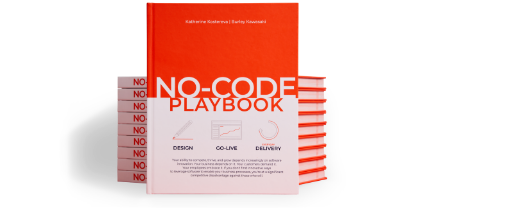Stage 9
Feedback Collection
The first Go-Live release is a huge milestone, and it’s easy to “take your foot off the gas” and allow things to coast, but now is the time when you need to keep the momentum going strong! This starts by collecting feedback. Feedback is an important stage as this is the first time when the no-code app will likely start having daily usage by real end users who are fully vested in the app working because it enables them to perform their job function. They will let you know when the app isn’t working right! View all types of feedback — even if it is critical — as a good thing because it will help you continue to improve and enhance the app.
It’s now a great time to start building a foundation for achieving perfection and make your app state of the art. By collecting and accommodating feedback from multiple dimensions, you empower yourself with data and information to tailor the application to perform at its best. The feedback provides you with actionable areas of improvement and opens up a lot of “blind spots” that you now can address. Getting a balanced approach to feedback collection is important. Here are some tips and best practices for establishing an efficient process.
Feedback Basics
First, let’s start by identifying three types of feedback inputs that we should be focused on collecting at this stage:
Stakeholder feedback
The feedback from the no-code stakeholder is essential as they are ultimately chartered with defining success for the app, which should have been outlined during the Business Use Case stage. How do they personally view the app based upon direct use? What feedback have they received from the teams using the app? Keep close to the no-code stakeholder — and perhaps cross-functional leaders in other groups that use the app — to keep a pulse on their feedback.
End user feedback
You need to look beyond the no-code stakeholder, however, and also gather feedback from the frontline users who use the app frequently (ideally daily). By listening to end users, you can collect a much higher volume of feedback and higher quality of insight since they are vigorously using the app.
System feedback
Finally, extracting and collecting system data from monitoring the app is important because it will help provide a highly objective view of UX and performance, and it may help you identify feedback in areas that could go unnoticed at first by end users. It will also help prevent feedback bias that may be skewed to a subset of highly vocal end users.
You’ll want to proactively develop a process for collecting a blend of data from each of the above feedback types (we’ll review some of the more common techniques and tools in the next section). Relying on just a single form of feedback can result in blind spots in your understanding of true system issues or areas for improvement. The feedback you collect from different sources will also help you validate/test the accuracy of the feedback.
Feedback Techniques
The two most common forms of gathering feedback usually start with tried-and-true classics: email surveys and focus groups.
-
Email surveys give you a broad way to collect feedback from your no-code app user base. Usually, they are easy and low-cost to prepare and distribute, especially when using common self-service survey-building tools. However, getting a high response rate may be a challenge given that your user base is focused on getting their job done and may not be able (or willing) to pause whatever critical tasks they are performing to give you feedback. If you send out a survey, keep it short —ideally, less than 7 or 8 minutes in length — focused, and personalized.
-
Focus groups give you a way to dive deeper into your end user’s feedback, and they are a good complement to the email surveys. A well-run focus group will give you richer qualitative feedback, helping you understand the “why” behind other feedback you’ve collected. It’s important to select the right set of users, though —identify a cohort of experienced users who will give you a rich source of insight.
Here are some additional techniques that you should consider to receive a more diverse and well-rounded feedback on your no-code app.
-
User shadowing is a qualitative feedback technique. It is conducted on a small scale using a defined sample of users who are observed (often by someone from the UX team) while using the no-code app just as they would in real life. The user is observed for a set period (ranging from 30 minutes to a few hours, depending upon the scope of the process). Ideally, the observer tries not to interfere with the user to avoid deviating from their natural practices of using the no-code app.
-
UX questionnaires complement other types of user surveys. They focus on app usability and seek to understand the user’s attitudes and preferences. Was using the no-code app the first time easy? Which parts of the app did they find confusing?This type of survey should avoid diving into the depth of features and, instead, focus on impressions of usability. Often, a UX questionnaire is structured around user personas with feedback being grouped and analyzed with a cohort of similar user types.
-
Feedback widgets are one of the most convenient methods for gathering real-time, quality user feedback. Placing a feedback widget into the app itself —often at the far right or bottom of a form — allows you to interact with your users within the app, which helps improve both the completion rate and relevancy of feedback.
-
Net Promoter Score (NPS) is a widely used market research metric first created by Bain & Company to predict customer loyalty. However, you may also find it helpful to use this approach for internal employee surveys. NPS surveys avoid survey fatigue by focusing the feedback on just a single question that is quick and easy to answer. It helps you keep your fingers on the pulse of how satisfied users are with the experience and whether they would recommend the app to others, such as coworkers for an internal app.
-
Usage analytics gather empirical data on actual app usage. This is important because it helps avoid subjective bias in the feedback you may collect from other sources. Usage analytics can often be collected from reporting provided by the no-code platform or sometimes through other analytics add-ons. This can give you accurate information on actual feature adoption, product friction points (i.e., areas where users get slowed down or halt entirely), product stickiness (how frequently users return to the app), and overall user engagement.
No one of these feedback strategies will give you a complete picture, so it’s recommended to adopt a multipronged feedback approach to how you gather, analyze, validate and gain insight into the real-world use of your no-code app.
Key Mistakes to Avoid
As you implement various programs of feedback collection, be aware of these common pitfalls:
Avoid the “squeaky wheel” syndrome
The loudest users may not be the best or most representative of the user population. Apply a structured approach to analyzing the overall feedback (from all three feedback types) to prevent input from a few users biasing your view on priorities or decisions.
Avoid infrequent app users
While collecting usability feedback from casual users is important, they will probably not give you the same depth of insight on functionality as “power users” who have demonstrated frequent activity.
Avoid moving too slowly
Note that the intensity of your feedback collection (and deployment of updates) plays a significant role at this stage. The pace of gathering and responding to feedback should be equal to the Go-Live cycle. It may include multiple weekly sessions to collect and analyze the inputs and get relevant decisions and approvals.
Final Takeaways
Feedback collection is essential to evolving your no-code app, but it’s important that you’re gathering the right feedback — through a combination of stakeholder, user, and system feedback — while taking a varied approach to input collection. Having a complete view of the areas of improvement for your no-code app is powerful and is enabled by a disciplined approach to continuous feedback collection and using that insight to evolve the application rapidly.
Now, what do you do with all the feedback you’ve collected? Let’s discuss this next!



